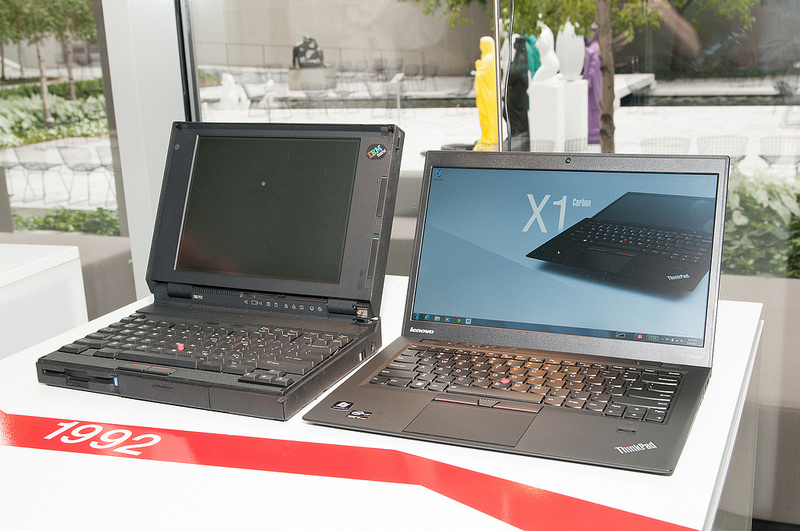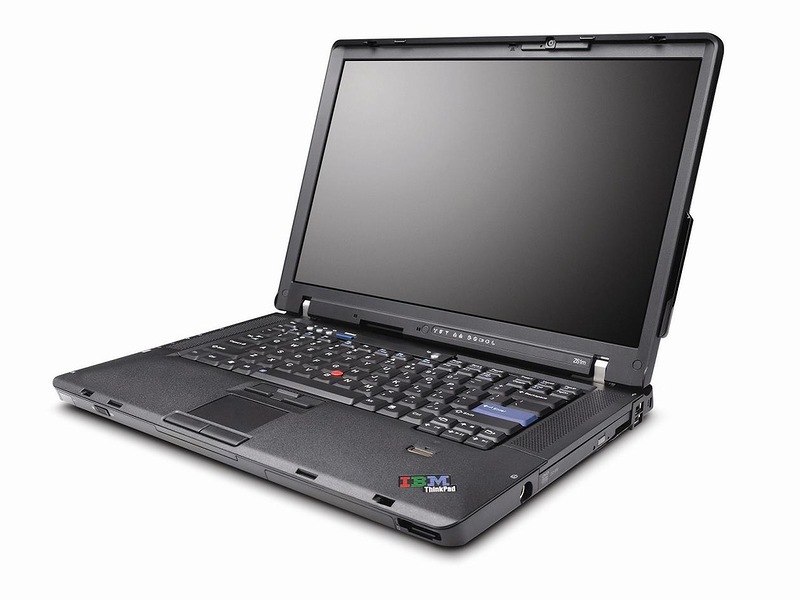ThinkPad Notebooks - 20 Years Old!
 “You will probably notice a small red little thing located in the center of the keyboard. This is Trackpoint II, and at the moment it is the most convenient and user-friendly control device in the industry. A small rubber joystick resembling a pencil eraser is located between the G and H buttons and works in tandem with two buttons under the space bar. ”
“You will probably notice a small red little thing located in the center of the keyboard. This is Trackpoint II, and at the moment it is the most convenient and user-friendly control device in the industry. A small rubber joystick resembling a pencil eraser is located between the G and H buttons and works in tandem with two buttons under the space bar. ”In December 1992, describing the newest IBM ThinkPad 700c, released two months earlier, PC Magazine columnist had to pay special attention to the trackpoint - the latest cursor control, which at that time was competing with a trackball and a regular external mouse. Since then, the trackpoint has become one of the most characteristic features of the ThinkPad notebook line, which most recently turned exactly 20 years old. In honor of this event, I want to talk about several outstanding models of the series.
Thinkpad 700c
In October 1992, IBM introduced five ThinkPad models and the 700s among them was the most sophisticated, and the only one with a color TFT display! The 10.4-inch matrix was the largest available at that time, and despite the rather mediocre by modern standards, the 100 to 1 contrast ratio, in the reviews and reviews of the first users in Usenet was called “bright, with large viewing angles, ideally suited for presentations. "

Speaking of processors. Comparing two processors with a difference of 20 years is quite problematic. Focusing only on the frequency is not very correct, but if so, then my working ThinkPad X220 is "faster" 700s 112 times. This is if we take the nominal frequency of the processor Core i7-2640M at 2800 MHz. And if you take into account Turbo Boost (3500 MHz), then at all - 140 times. Not to mention that the processor is dual-core. The results in the SuperPI test, which uses only one core, are much more interesting. So, a modern laptop calculates the Pi number to the millionth decimal place in 11.7 seconds. A computer with the same processor used in 700s - 2 days 10 hours 47 minutes and 30 seconds! And this already gives a performance increase of 18 thousand times.
Trackpoint appeared in ThinkPad laptops far from immediately. "Red thing" has been developed since 1984. The creator of the trackpoint, Ted Selker, then an employee of the famous Xerox PARC laboratory, tried to solve a problem that is still relevant until now: moving the hand from the keyboard to the mouse and back takes time, and it takes a lot of time. The same can be said about modern touchpads. However, earlier ThinkPad samples used the more common trackballs. One of the pros of the trackpoint was that it integrates into the keyboard. There were fears that the convenience of printing would decrease, and for IBM, typing comfort was one of the company's important values, which was also the manufacturer of the popular IBM Selectric typewriters. However, the trackpoint has been adopted as the standard for ThinkPad laptops. to this day is a hallmark of the notebook series. What this old advertising strip is clearly saying:

By the way, the younger version of the laptop is advertised, which still works for me .
ThinkPad 755C
 1994 model, available in three different versions. They can be used to evaluate what laptop buyers could save on. The cheapest version for $ 2,800 was equipped with a 170-megabyte hard drive and a 486 DX2 50 MHz processor. The most expensive one had a more powerful 486 DX4 75 MHz processor and a 540-megabyte hard drive.
1994 model, available in three different versions. They can be used to evaluate what laptop buyers could save on. The cheapest version for $ 2,800 was equipped with a 170-megabyte hard drive and a 486 DX2 50 MHz processor. The most expensive one had a more powerful 486 DX4 75 MHz processor and a 540-megabyte hard drive.A separate special version was called the “multimedia station” and was equipped (for the first time in the world!) With a two-speed CD-ROM drive. The kit also included a docking station with a five-inch (!) Expansion slot. Cost - 6400 dollars! But that is not all. For a surcharge of $ 2,000, the built-in drive could be replaced with a module that allows data to be transmitted over a cellular network (analog AMPS standard) at a speed of 14.4 kilobits per second.
And this is the first ThinkPad, which, after tests for radiation exposure and direct exposure to fire, was sent to space.
Thinkpad 701c

Compared to the ThinkPad 700c, the 1995 ThinkPad 701c lost 1.4 kilograms and ... went up by $ 1,000, and also got a full-fledged sound card. But most of all he was remembered for his unique keyboard. She advocated the dimensions of the laptop and completely hid inside the closed state, due to a special mechanism. This is best demonstrated in the commercial of those times:
A model with a fairly decent battery life (on average 3 hours from the built-in nickel-cadmium battery) received a favorable assessment in the computer press, despite the cost and the fact that by then new, more powerful Intel Pentium series processors were already available. However, the Intel 486 DX4 75 MHz processor was quite fast at the time. The lag behind modern models has also been significantly reduced - such a computer counts 1 million characters in SuperPI in 1 hour 8 minutes 21 seconds (the difference with Core i7 is 350 times, in frequency - 37.3 or 46.6 times).
ThinkPad 240X

An extraordinary representative of the new century, released in June 2000. It was equipped in a top configuration with a Mobile Pentium III 500 MHz processor, 64 megabytes of RAM and a 10.4-inch screen with a resolution of 800x600. Hard disk - 6 or 12 gigabytes. A distinctive feature of this model was the minimum weight - 1.35 kg. Approximately the same weight as the modern ThinkPad X230, though already with a 12.5-inch display. In the same year, the ThinkPad i-series was introduced, the first in the world equipped with a WiFi module.
ThinkPad Z61m

This laptop was released in May 2006, after the acquisition of the IBM computer division by Lenovo. This model is already "AD", with a dual-core Intel Core Duo processor, a 100-gigabyte hard drive and an optional 3G module. The uniqueness of this model lies in the material of the display cover - it is titanium!
What's next?
In the third quarter of this year, Lenovo first took first place in the personal computer market in the world. Over the past few years, we have often been the only company showing growth in the notebook market. It's no secret that the market for classic computers is no longer growing at the same pace as before, and by the end of 2012 a slight drop in sales is also predicted. Someone is talking about the beginning of the Post PC era. We believe that it is more correct to call the new state of affairs the era of PC +. Despite the growing popularity of tablets and smartphones, the main tool for creating content remains a laptop or desktop computer. Lenovo launches all three types of devices, and also offers mobile devices that share the same features of laptops and tablets:

We will talk about the new ThinkPad transformer models very soon. Stay in touch!
